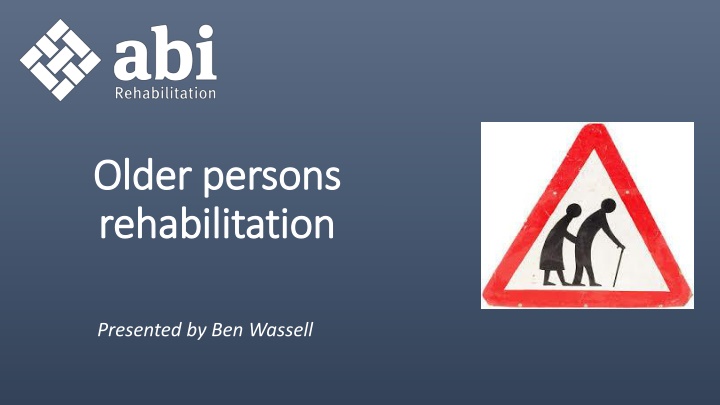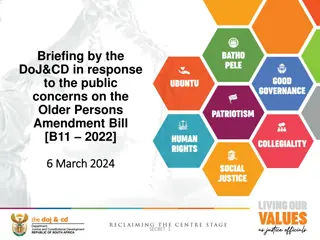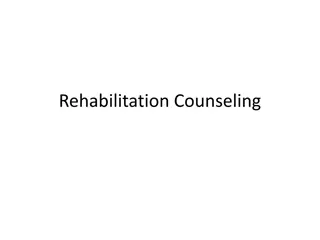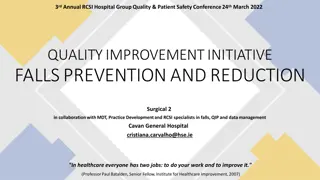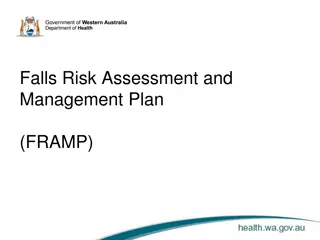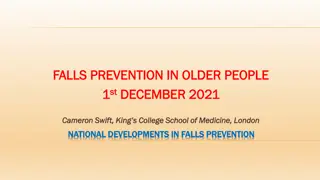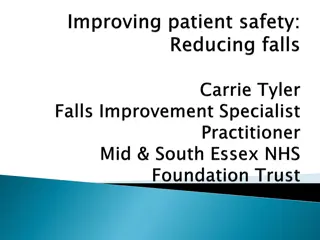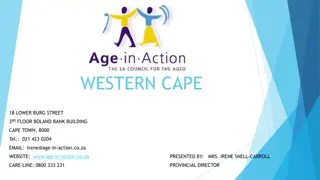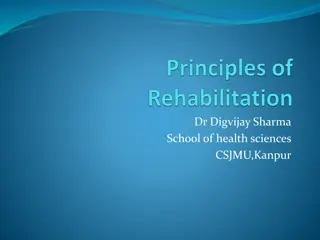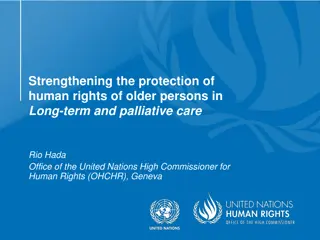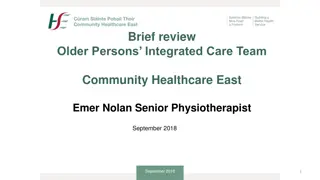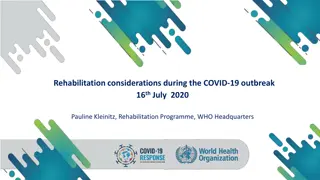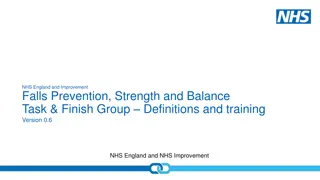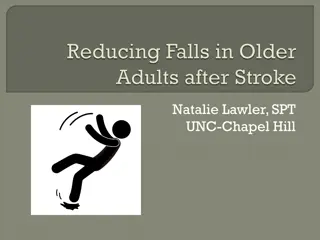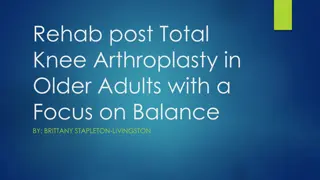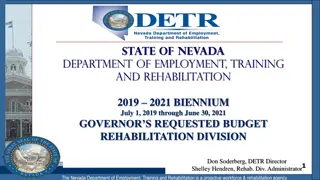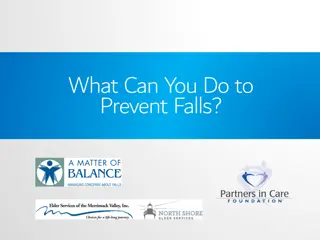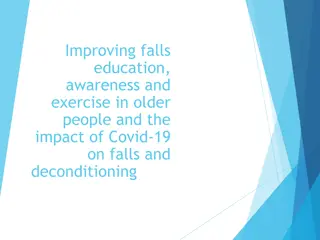Rehabilitation Strategies for Older Persons with Falls Risk
Implementing exercise programs, such as strength training and cardiovascular activities, to reduce falls risk in the older TBI population is crucial. Choosing the right type of exercises, like balance-focused programs, can significantly impact fall prevention. Additionally, exploring the benefits of Tai Chi versus Otago Exercise Programme can provide insights into effective community-based interventions. To better predict falls risk, assessing gait and mobility outcomes objectively and subjectively is essential. Understanding the influence of post-traumatic amnesia state on falls risk can further enhance fall prevention strategies.
Download Presentation

Please find below an Image/Link to download the presentation.
The content on the website is provided AS IS for your information and personal use only. It may not be sold, licensed, or shared on other websites without obtaining consent from the author.If you encounter any issues during the download, it is possible that the publisher has removed the file from their server.
You are allowed to download the files provided on this website for personal or commercial use, subject to the condition that they are used lawfully. All files are the property of their respective owners.
The content on the website is provided AS IS for your information and personal use only. It may not be sold, licensed, or shared on other websites without obtaining consent from the author.
E N D
Presentation Transcript
Older Older persons persons rehabilitation rehabilitation Presented by Ben Wassell
Exercise parameters Strength At least 2 days week Cardiovascular 5 days per week (moderate intensity) or 3 days per week (vigorous intensity) 150 min of mod-intensity aerobic activity per week or as physically active as chronic conditions allow General For most health outcomes, additional benefits occur as the amount of physical activity increases through higher intensity, greater frequency, and/or longer duration (ACSM guidelines 2011), (Garber et al ,2011)
How do we better predict and reduce falls risk within our older TBI population?
What type of exercises? Gold- High dose balance and no walking program Silver- High dose balance and walking program Bronze- Low dose balance and walking program Walking programs without a balance program may increase falls risk. Strength and balance sets the foundation before walking practice. (Sherrington, 2008)
Tai Chi vs Otago Exercise Programme Tai Chi OEP Community based = Travel Home based = No travel VS Supervision 1:15 Isolation Social interaction*** Unsupervised Individually Prescribed** One size fits all Home exercise program over 4 trials in people over 80 30-46 percent reduction in falls, 28-39 percent reduction in injury Fewer hospital admissions, Increased exercise function 55 % decreased in mortality risk (Liu Ambrose etal. 2008 JAG 56, 1821-1830) (Thomas et al. 2010 Age Ageing 39, 681-687)
Questions What outcomes should we use to better predict falls from a gait/mobility perspective? Objective, subjective or Both? Do objective falls risk predictors match subjective measures? Does post traumatic amnesia state have an influence on falls risk based on objective or subjective measures?
Objective measures Berg-49/56 Step test- <7 (D/c from outpatients) Step Test- 10 (Outpatients rehab) 10MWT- >12 (comfortable) FSST- >15 seconds/inability to complete (FES-I associated with poor FSST result) 6MWT- 250m ST & FSST (four square step test)- implicated due to high risk of trips; obstacle navigation 15 seconds (community dwelling) 12 sec (vestibular disorders)= falls risk 70-78% prediction of falls if < cut off score (Mackintosh et al., 2006), (Blennerhassett, 2012) (Joshi & Sadhale, 2014 )
Subjective measure FES-I Fear of falling questionnaire Validated in Neurological populations and older populations (Delbaere et al, 2010)
Data recorded Admissions over a 6 month period Aged >65 years of age 12 Subjects tested Recorded at admission and discharge 3 objective measures 1 subjective measure PTA testing (Westmead)
PTA State 11 of the 12 subjects tested had PTA scores of 10 or higher on admission 2 remained in PTA on discharge No clear correlation between level of PTA, falls risk or fear of falling
High Fear of falling Moderate fear of falling Low Fear of Fall (FESI) 1 1 2 4 3 8 Falls risk Not a falls risk Falls risk Not a falls risk Falls risk Not a falls risk 75 percent of those who presented as having a low fear of falling were considered a high falls risk based on objective outcome measures 67 percent of those who presented as having a moderate fear of falling were considered a high falls risk based on objective outcome measures 89 percent of those who presented as highly fear full of falling were also considered a high falls risk based on objective outcome measures
Admission Discharge No change= 5 Moderate to low= 2 High to moderate= 1 Client 1. Admission: Objective 3/3 Subjective Low Client 2. Admission: Objective 2/3 Subjective High Discharge: Objective 1/3 Subjective Low Discharge: Objective 1/3 Subjective High Client 3. Admission: Objective 0/3 Subjective Moderate Client 4. Admission: Objective 3/3 Subjective Moderate Discharge: Objective 0/3 Subjective Moderate Discharge: Objective 0/3 Subjective Low Client 5. Admission: Objective 3/3 Subjective High Discharge: Objective 2/3 Subjective Moderate Discharge: Objective 0/3 Subjective High Client 6. Admission: Objective 3/3 Subjective High
Results No clients had any falls during the study. No clear correlation between low and moderate fear of falling (FES1) and objective measures (Berg, Step Test, 10MWT) in TBI clients over 65. PTA state does not seem to have an effect on fear of falling or falls risk.
Discussion 3 objective measures seem to be an effective falls predictor for our over 65 TBI population. Subjective measures weak predictor of falls in this population group? Is a subjective measure (FESI) a good adjunct to our falls assessment measures though? PTA state (depth of PTA) Risk taking behaviour is not necessary based on PTA in this population.
References ACSM guidelines (2011) Medicine & Science in Sports & Exercise The official journal of ACSM Blennerhassett JM, Dite W, Ramage ER, Richmond ME. (2012) Changes in balance and walking from stroke rehabilitation to the community: a follow-up observational study Arch physical rehab. 93(10):1782-7. Delbaere, K, Close JC, Heim J, Sachdev PS, Brodaty H, Slavin MJ, Kochan NA, Lord SR. (2010) The Falls Efficacy Scale International (FES-I). A comprehensive longitudinal validation study Age Aging 39(2):210-6. Garber, Carol E, Blissmer B, Deschenes M, Franklin B, Lamonte M, Lee I, Nieman D, Swain D. (2011) Quantity and Quality of Exercise for Developing and Maintaining Cardiorespiratory, Musculoskeletal, and Neuromotor Fitness in Apparently Healthy Adults: Guidance for Prescribing Exercise Medicine & Science in Sports & Exercise. 43: 1334-1359. Joshi S, Sadhale A. (2014) Predicting Falls in Elderly : A Comparison between Berg Balance Scale & Dynamic Gait Index Indian Journal of Physiotherapy & Occupational Therapy. 8(3): 136-140. Liu-Ambrose T, Donaldson MG, Ahamed Y, Graf P, Cook WL, Close J , Lord SR, Khan KM. (2008) Otago home-based strength and balance retraining improves executive functioning in older fallers: a randomized controlled trial Journal of American Geriatrics. 56(10):1821-30. Mackintosh SF, Hill KD, Dodd KJ, Goldie PA, Culham EG. (2006) Balance score and a history of falls in hospital predict recurrent falls in the 6 months following stroke rehabilitation Arch Phys Med Rehabil. 87(12):1583-9 Sherrington C, Michaleff Z, Fairhall N, Paul S, Tiedemann A, Whitney J, Cumming R, Herbert R, Close J, Lord S. (2008) Effective exercise for the prevention of falls: a systematic review and meta-analysis 56(12):2234-43. Thomas S, Mackintosh S, Halbert J. (2010) Does the Otago exercise programme' reduce mortality and falls in older adults?: a systematic review and meta-analysis Age Ageing. 39(6):681-7.
